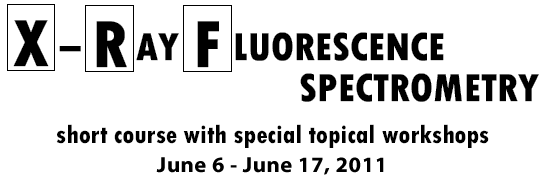
XRF2011
Overview
THE SHORT COURSE
XRF2011 will continue using the teaching material compiled from the course at University of Cape Town since 1974 and this one at The University of Western Ontario since 1990 by Professors James Willis and Andy Duncan, published by PANalytical B.V. in 2008.
This course has been improved through the past 20 years to take into account of new knowledge and directions in XRFS. It will take the form of a series of lectures, each followed by a laboratory exercise session. The course content is based on both wavelength dispersive (WDXRFS) and energy dispersive (EDXRFS) methods. Participants will carry out tutorial calculations on test data sets to familiarize themselves with the procedures involved.
Lecturers will include Mike Hinds (Royal Canadian Mint), Maggi Loubser (PPC Cement), Alexander Seyfarth (Bruker-axs, Inc.), Bruno Vrebos (PANalytical, Inc. and Charles Wu (The University of Western Ontario).
AN INTENSIVE EXPERIENCE
Each week can be attended separately, BUT persons attending the second week on quantitative analysis MUST have previously attended the introductory first week, although not necessarily in the same year. This is a very full, very intensive course containing an enormous amount of detail and building very rapidly on itself. It is no holiday! For participants with little or no theoretical or practical knowledge of XRFS, it is recommended that only the introductory week be attended in the first year. After gaining a year's experience in the laboratory and building on the knowledge gained from the first week, such participants will be in a much stronger position to extract the maximum advantage from the second week of the course.
INSTRUCTOR AND PEER SUPPORT
The experience of past participants has ranged from a few months to over fifteen years in the field of spectrometric analysis. Such a mixed group often creates a stimulating environment in discussions during the course. This is aided by the fact that course participants and lecturers stay at the same accommodation venue. In order to provide ideal tutorial instruction to all the participants, the class size will be limited such that participant to instructor ratio will not exceed 8:1.
Also from this web page:
Registration
XRF2011 Short Course
Sample Prep Workshop
Portable XRF Analyzer Workshop
Contact
Course Coordinator:
Charles Wu (ctwu@uwo.ca)

